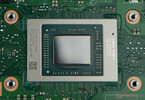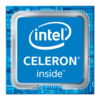AMD Ryzen 5 4500U vs Intel Celeron 5305U vs AMD Ryzen 7 4980U
AMD Ryzen 5 4500U
► remove from comparison
The AMD Ryzen 5 4500U is an upper mid-range, hexa-core processor of the Renoir product family. The APU was unveiled in H1 2020; it is designed for use in thinner, lighter laptops. Its six Zen 2 CPU cores run at 2.3 GHz (base clock speed) to 4.0 GHz (highest Boost frequency possible). Ryzen 5 4500U features the Vega 6 iGPU.
The sole advantage of Ryzen 5 4600U over Ryzen 5 4500U is the thread-doubling SMT technology support. The former has SMT while the latter does not.
Architecture
Zen 2 is a resounding success, delivering massive improvements over outgoing Zen Plus-based processors. Ryzen 5 4500U is manufactured on the cutting-edge 7 nm TSMC process; it is compatible with dual-channel DDR4-3200 or quad-channel LPDDR4-4266 memory. This processor has 8 MB of Level 3 cache.
While the APU uses Zen 2 cores just like the desktop-grade Ryzen 3000-series processors do, Ryzen 7 3800XT included, it does does not have PCI-Express 4.0 support. It does feature several PCI-Express 3.0 lanes for connecting discrete graphics cards, SSDs and other devices. Four PCI-Express 3.0 lanes allow for read/write rates of up to 3.9 GB/s provided a suitably fast NVMe SSD is used.
Ryzen 5 4500U gets soldered permanently on to the motherboard (FP6 socket interface) and is anything but user-replaceable.
Performance
The average Ryzen 5 4500U in our database nearly matches the Core i5-11300H, the Core i5-11320H and also the AMD Ryzen 3 5300U as far as multi-thread benchmark scores are concerned - thus delivering an undeniably impressive performance jump over the outgoing Ryzen 5 3500U.
Thanks to its decent cooling solution and a long-term power limit of 38 W, the Xiaomi RedmiBook 16 R5 is among the fastest systems powered by the R5 4500U that we know of. It can be about 20% faster in CPU-bound workloads than the slowest system built around the same chip in our database, as of August 2023.
Graphics
Just like its name suggests, the Radeon RX Vega 6 graphics adapter has 6 Compute Units (6 x 64 = 384 unified shaders). In the case of Ryzen 5 4500U, this graphics adapter runs at up to 1,500 MHz. The iGPU definitely supports UHD 2160p monitors at 60 Hz; it will have no trouble HW-decoding HEVC, AVC, VP9, MPEG-2 and other widespread video codecs. AV1 is not supported though; such a video will have to be software-decoded for much lower energy efficiency.
Vega 6 will let you play many titles of 2020 and 2021 as long as you stick to low settings and low resolutions. F1 2021 (720p, Low) runs at 32 fps; Outriders (720p, Low) runs at 27 fps, to give you an example or two. As the iGPU has no VRAM of its own, it is paramount that fast system RAM is used.
Power consumption
This Ryzen chip is very energy efficient, as of mid 2022, thanks to the cutting-edge 7 nm TSMC manufacturing process and the mature Zen 2 architecture.
The Ryzen 5 4500U has a default TDP (also known as the long-term Power Limit) of 15 W that can be changed to anything between 10 W and 25 W by laptop makers if required, a right they use more often than not. Clock speeds and performance will change accordingly as a result. By going for the lowest value, it will be possible to use the APU as the heart of a passively cooled tablet, laptop, mini-PC.
Intel Celeron 5305U
► remove from comparison
The Intel Celeron 5305U is a low-power dual-core SoC for laptops, based on the Comet Lake architecture, which was introduced in 2020. Compared to Kaby Lake and Whiskey Lake, there are apparently no differences with Comet Lake apart from the two additional cores in the Top model Core i7-10710U. The processor is still manufactured using the mature 14nm process (14nm++ like Whiskey Lake). The processor cores clock at a fixed 2.3 GHz (no Turbo) and also only offer 2 threads (no HyperThreading). Compared to the more powerful Core i3, i5 and i7 variants, the Celeron does not offer SSE (2) support.
You can find more information about the Comet Lake architecture and the available processors on our Comet Lake topic page.
According to Intel, the integrated graphics card is called Intel UHD Graphics, but is an old Intel UHD Graphics 610. It is clocked in the Celeron 5205U at 300 - 900 MHz and is only sufficient for very demanding games. The CPU also offers an integrated DDR4-2666 / LPDDR4x 2933 / LPDDR3-2133 dual-channel memory controller as well as VP9 and H.265 video decoder and encoder.
Performance
The performance of the Celeron 5305U is in the lowest entry-level class of notebook processors in 2020. Due to the lack of Turbo and only 2 cores, the CPU cannot score points in either single-core or multi-core tasks. The processor is therefore only suitable for undemanding tasks such as surfing with a few tabs and office tasks.
The power consumption and performance can be set from 15 to 12.5 watts by the notebook manufacturer via cTDP-down. However, the processor then only runs at 800 MHz and significantly reduced performance. Even at 15 watts, however, the processor is suitable for thin and light notebooks.
AMD Ryzen 7 4980U
► remove from comparison
The AMD Ryzen 7 4980U is a Renoir family processor designed for certain Microsoft Surface systems. 4980U has eight Zen 2 cores clocked at 2.0 GHz (base clock speed) to 4.4 GHz (Boost) with thread-doubling SMT tech enabled for a total of 16 threads. The chip is manufactured on the modern 7 nm TSMC process and partly thanks to that AMD promises a 2x improvement in performance-per-Watt over Ryzen 3000 series mobile CPUs.
Architecture
The Zen 2 microarchitecture has brought a sizeable per-thread performance boost compared to the outgoing Zen+ parts. Renoir product family is also the first to introduce 8-core ULV processors to laptop market, keeping power consumption within reasonable limits. This AMD processor family is very impressive from most perspectives. One of the disatvantages to keep in mind is the lack of PCI-Express 4 support, meaning these blazing-fast NVMe SSDs will be limited to 3.9 GB/s tops.
Ryzen 7 4980U is designed to work with quad-channel LPDDR4 memory at up to 4,267 MHz. 8 MB of Level 3 are present in this chip. The Ryzen 7 gets soldered straight to the motherboard (FP6 socket) and is thus not user-replaceable. Please go to our Renoir hub page for more information on the product family.
Performance
The 4980U is the fastest U-class Ryzen 4000 series chip. As such, its clock speeds are 200 MHz higher (both the base one and Boost one) than what the Ryzen 7 4800U has.
It is thus hardly surprising that the average 4980U in our database is in the same league as the Ryzen 7 5800U and also the Core i7-1260P, as far as multi-thread benchmark scores are concerned.
Graphics
In addition to its eight CPU cores, the Ryzen 7 also features the Radeon RX Vega 8 graphics adapter with 8 CUs (= 512 shaders) at up to 1,950 MHz. This iGPU is compatible with FreeSync and DirectX 12 and is able to HW-decode AVC, HEVC, VP9-encoded videos (no AV1 support here). Vega 8 is capable of outputting UHD 2160p60 video signal to several monitors and, similar to Intel's Iris Xe (80 EUs), is good enough for a bit of light gaming on the go, provided one is content with sub-1080p resolutions and low/medium quailty presets.
Power consumption
The APU has a default TDP, also known as the long-term power limit, of 15 W; much like it is with other U-class Ryzen 4000 chips, AMD is fine with laptop makers (Microsoft, in this case) changing that value to anything between 10 W and 25 W.
The 7 nm TSMC process this Ryzen 7 is built with makes for above average, as of mid 2022, energy efficiency.
| Model | AMD Ryzen 5 4500U | Intel Celeron 5305U | AMD Ryzen 7 4980U | ||||||||||||||||||||||||||||||||||||||||||||||||||||||||||||||||||||||||||||||||||||||||||||||||
| Codename | Renoir-U (Zen 2) | Comet Lake-U | Renoir-U (Zen 2) | ||||||||||||||||||||||||||||||||||||||||||||||||||||||||||||||||||||||||||||||||||||||||||||||||
| Series | AMD Renoir (Ryzen 4000 APU) | Intel Comet Lake | AMD Renoir (Ryzen 4000 APU) | ||||||||||||||||||||||||||||||||||||||||||||||||||||||||||||||||||||||||||||||||||||||||||||||||
| Series: Renoir (Ryzen 4000 APU) Renoir-U (Zen 2) |
|
|
| ||||||||||||||||||||||||||||||||||||||||||||||||||||||||||||||||||||||||||||||||||||||||||||||||
| Clock | 2300 - 4000 MHz | 2300 MHz | 2000 - 4400 MHz | ||||||||||||||||||||||||||||||||||||||||||||||||||||||||||||||||||||||||||||||||||||||||||||||||
| L1 Cache | 384 KB | 512 KB | |||||||||||||||||||||||||||||||||||||||||||||||||||||||||||||||||||||||||||||||||||||||||||||||||
| L2 Cache | 3 MB | 4 MB | |||||||||||||||||||||||||||||||||||||||||||||||||||||||||||||||||||||||||||||||||||||||||||||||||
| L3 Cache | 8 MB | 8 MB | |||||||||||||||||||||||||||||||||||||||||||||||||||||||||||||||||||||||||||||||||||||||||||||||||
| Cores / Threads | 6 / 6 | 2 / 2 | 8 / 16 | ||||||||||||||||||||||||||||||||||||||||||||||||||||||||||||||||||||||||||||||||||||||||||||||||
| TDP | 15 Watt | 15 Watt | 15 Watt | ||||||||||||||||||||||||||||||||||||||||||||||||||||||||||||||||||||||||||||||||||||||||||||||||
| Technology | 7 nm | 14 nm | 7 nm | ||||||||||||||||||||||||||||||||||||||||||||||||||||||||||||||||||||||||||||||||||||||||||||||||
| max. Temp. | 105 °C | 100 °C | 105 °C | ||||||||||||||||||||||||||||||||||||||||||||||||||||||||||||||||||||||||||||||||||||||||||||||||
| Socket | FP6 | BGA1528 | FP6 | ||||||||||||||||||||||||||||||||||||||||||||||||||||||||||||||||||||||||||||||||||||||||||||||||
| Features | DDR4-3200/LPDDR4-4266 RAM, PCIe 3, MMX, SSE, SSE2, SSE3, SSSE3, SSE4A, SSE4.1, SSE4.2, AVX, AVX2, BMI2, ABM, FMA, ADX, SMEP, SMAP, CPB, AES-NI, RDRAND, RDSEED, SHA, SME | LPDDR3-2133/DDR4-2400 RAM, PCIe 2, 4 GT/s bus, MMX, SSE, SSE2, SSE3, SSSE3, SSE4.1, SSE4.2, AVX, AVX2, BMI2, ABM, FMA, ADX, VMX, SMEP, SMAP, MPX, EIST, TM1, TM2, SST, AES-NI, RDRAND, RDSEED, SGX | LPDDR4-4266 RAM, PCIe 3, MMX, SSE, SSE2, SSE3, SSSE3, SSE4A, SSE4.1, SSE4.2, AVX, AVX2, BMI2, ABM, FMA, ADX, SMEP, SMAP, SMT, CPB, AES-NI, RDRAND, RDSEED, SHA | ||||||||||||||||||||||||||||||||||||||||||||||||||||||||||||||||||||||||||||||||||||||||||||||||
| iGPU | AMD Radeon RX Vega 6 (Ryzen 4000/5000) ( - 1500 MHz) | Intel UHD Graphics 610 (300 - 900 MHz) | AMD Radeon RX Vega 8 (Ryzen 4000/5000) ( - 1950 MHz) | ||||||||||||||||||||||||||||||||||||||||||||||||||||||||||||||||||||||||||||||||||||||||||||||||
| Architecture | x86 | x86 | x86 | ||||||||||||||||||||||||||||||||||||||||||||||||||||||||||||||||||||||||||||||||||||||||||||||||
| Announced | |||||||||||||||||||||||||||||||||||||||||||||||||||||||||||||||||||||||||||||||||||||||||||||||||||
| $107 U.S. | |||||||||||||||||||||||||||||||||||||||||||||||||||||||||||||||||||||||||||||||||||||||||||||||||||
| Manufacturer | ark.intel.com | www.amd.com |
Benchmarks
Average Benchmarks AMD Ryzen 5 4500U → 0% n=0
Average Benchmarks Intel Celeron 5305U → 0% n=0
Average Benchmarks AMD Ryzen 7 4980U → 0% n=0
* Smaller numbers mean a higher performance
1 This benchmark is not used for the average calculation













